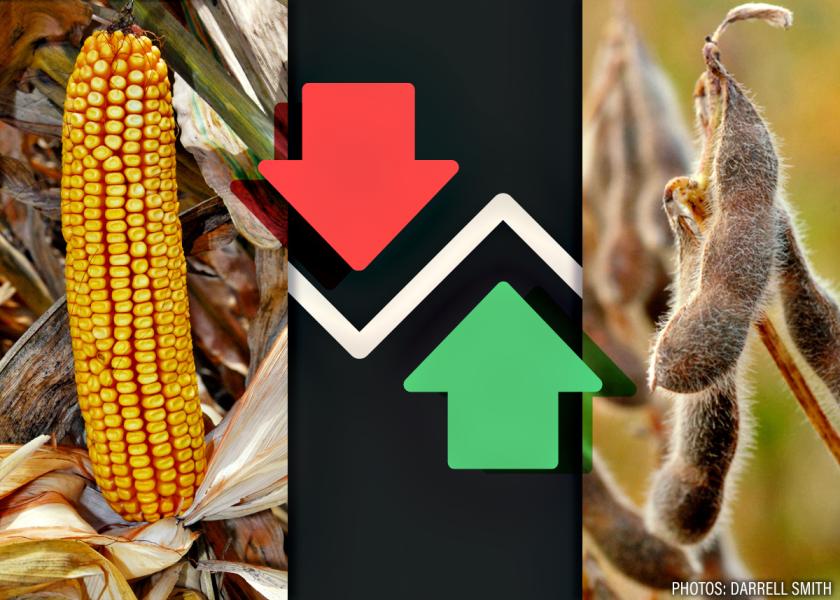Grain and Livestock Futures Mostly Lower for 2023. So, What’s Ahead in 2024?

Grain futures ended mostly lower for 2023. Spot month corn prices were down the most losing 30%, while soybeans only dropped half that amount, off 15% for the year. Soybean meal fell 18%, soybean oil 25%. Kansas City Hard Red Winter wheat slid 28%, Chicago Soft Red Winter wheat lost 21% and Minneapolis Hard Red Spring wheat 23%. Lean hog futures dropped 22%, leaving cattle one of the few winners of the year with Live Cattle up 7% and Feeder Cattle up 20%.
After grain markets set record highs in 2022 a rebound in United States production led to a commodity reset in 2023 similar to 2013. Randy Martinson, Martinson Ag, says that was especially true for corn with a record 15.234-billion-bushel crop, at the same time more than half of the U.S. was hit by drought during the growing season. “We had better production than expected, we had poor exports and so all that came into play to kind of push the market lower. The drop in corn at 30%, that’s the largest yearly percentage drop in 10 years. So that’s pretty significant and when you have a 2.1-billion-bushel carryover estimate the market doesn’t really need to do a lot.”
Soybean prices were down only 15% compared to the end of 2022. The U.S. soybean crop came in at 4.129 billion bushels for 2023, but compared to corn ending stocks are historically tight at only 245 million bushels. That, combined with strong crush margins most of the year and recent uncertainty about the Brazilian crop have held the soybean market together better than corn or wheat.
With the commodity reset there is also carry in the market with higher prices in deferred futures contracts. This year the market is telling farmers it doesn’t need the crop right now whereas in 2022 the market was bidding in the front months to attract bushels. That requires a different marketing strategy for 2023 stored bushels. Martinson says, “Right now producers should be looking to take advantage of that carry, especially in the corn market in the May or July time frame. Soybeans are different and farmers may want to look at marketing in the next month to six weeks before Brazil starts dumping their crop on the market.”
Corn and soybean markets have been trading sideways for the last few months and Martinson says to get a meaningful rally it will take some sort of supply or demand shock to the market. The current supply shock the market is waiting for is the results of Brazil’s crop, which has faced weather issues from drought in the north to flooding in the south. “That will come into full focus after the first of the year,” he says. Many private firms have already lowered Brazil production with the lowest at 153 million metric tons, but more will be known in January when harvest results start coming in.
On the demand side, the soybean market was pinning its hopes on renewable fuels growth according to Martinson, but in 2023 but bean oil was a poor performer dropping 25%, so that is the next demand story that could support soybeans.
For corn, export pace needs to pick up. It has had plenty of headwinds with high prices, a strong dollar and a host of transportation challenges including low water levels on the Mississippi River. However, the biggest demand shock could come from China if they ramped up their purchases similar to 2020-21. He says, “Looking at China they’re down big from last year for both soybeans and corn.” Turning that around is dependent on the outcome of the soybean crop in Brazil and the second crop safrinha corn if they abort acres because of the delayed planting season.
The wheat complex also had a tough year as traders became numb to Black Sea war headlines. However, the biggest negative was Russia flooded the market with cheaper wheat, undercutting the U.S. and other competitors in the export market. “The stronger U.S. dollar didn’t help with that,” says Martinson. The other factor was a better-than-expected winter wheat and spring wheat crop in the U.S. So, we had a lot more supply.” Plus, commodity funds were also short in all three wheat exchanges for most of the year, which added pressure.
Just like corn and soybeans, Martinson says the wheat market will be dependent on better demand to see a price improvement in 2024. “I am hoping that with the recent weakening of the dollar that picture will improve.”







